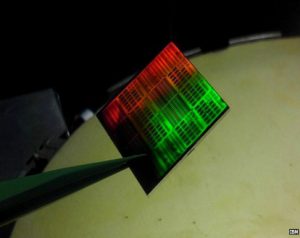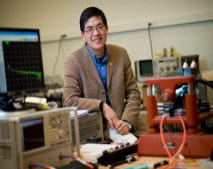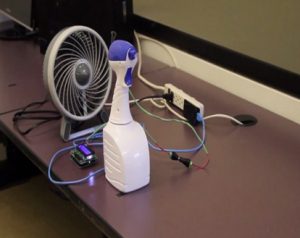Researchers at the University of Vermont have created a new method to handle the strain new electric vehicles will place on the nation’s electric grid. Plug-in electric vehicles, while still a small portion of the automotive market, continue to grow rapidly in popularity in part due to decreasing manufacturing costs and wider availability. In 2013, sales of full electric and … [Read more...]
Better Magnetic Spin Wave Control for Electronic Devices
Researchers have developed a method for creating and controlling quick-moving waves in magnetic fields they say could improve communication and information processing in computer chips and other electronic devices. Created by scientists in the Department of Physics at New York University, the new technique relies on “spin waves,” waves that move in magnetic materials similar … [Read more...]
Graphene Circuit Competes with Silicon Technology
Scientists at IBM have taken their graphene research a step further with the development of what they claim is the world’s most advanced, fully functional integrated circuit made of wafer-scale graphene. According to the researchers, the new graphene-based IC acts as a radio frequency receiver performing signal amplification, filtering and downconversion mixing and is … [Read more...]
Signal and Spectrum Analyzer Features 500 MHz Bandwidth
Rohde & Schwarz has announced the availability of the new R&S FSW-B500 hardware option for all analyzers of the R&S FSW family, enabling measurements in a frequency range up to 67 GHz for applications including research and development, radar and satellite and testing of wireless connections such as WLAN or Beyond 4G (5G). According to the company, the large … [Read more...]
RF MEMS Technology May Increase Antenna Efficiency
A technology often used in satellite and defense applications may drastically improve smartphone performance in the near future by increasing antenna efficiency, according to new research from scientists at the University of California San Diego School of Engineering. Antennas in many modern smartphones do not function optimally in 3G and 4G/LTE wireless environments, say the … [Read more...]
Inductor Tuning Method Could Shrink Cell Phones
Scientists at Northeastern University in Massachusetts have devised a new method of tuning radio frequency circuits that could reduce the size and improve the performance of smartphones and other RF devices. “Every radio-frequency resonance circuit has two components: an inductor and a capacitor. [However,] for the many decades that we've been using RF devices, we've only been … [Read more...]
Next-Gen Flight Control System Vulnerable to Jamming Attacks
An international team of scientists has released research highlighting vulnerabilities in the upcoming next-generation air traffic control system. The new Automatic Dependent Surveillance-Broadcast (ADS-B) system is susceptible to jamming or intentional interference from attackers in possession of a wireless network and off-the-shelf equipment, according to researchers from … [Read more...]
Graphene Nanoantennas May Enable Tiny Networks
Scientists have released new theoretical research that suggests tiny nanoscale antennas made from graphene could overcome the limits of similar antennas fabricated from traditional metal components to enable highly efficient networks of nanomachines. Graphene, a material comprised of a hexagonal structure of carbon atoms, is capable of generating a type of “electronic surface … [Read more...]
Wireless Molecular Network Uses Alcohol to Send Text Messages
Scientists have successfully transmitted a text message via the world’s first wireless molecular network in a breakthrough that could lead to better methods of sending data in challenging underground or underwater environments where electromagnetic waves cannot be used. To send their message, researchers at the University of Warwick in the UK and the York University in Canada … [Read more...]
Optical “Tuning Fork” May Help Stabilize Light Frequencies for Better Electronics
Researchers at the California Institute of Technology (Caltech) have developed an optical “tuning fork” device they say could help improve high-speed communications, navigation and remote sensing by stabilizing the signals of high-quality lasers and the electrical currents needed to power electronics. "When you're tuning a piano, a tuning fork gives a standardized pitch, or … [Read more...]
- « Previous Page
- 1
- …
- 32
- 33
- 34
- 35
- 36
- …
- 41
- Next Page »













